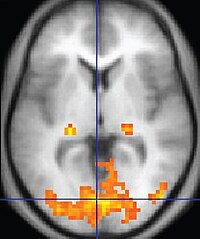
Photo from wikipedia
Objective: The efficacy of deep brain stimulation (DBS) depends on accurate placement of electrodes. Although stereotactic frames enable co-registration of image-based surgical planning and the operative field, the accuracy of… Click to show full abstract
Objective: The efficacy of deep brain stimulation (DBS) depends on accurate placement of electrodes. Although stereotactic frames enable co-registration of image-based surgical planning and the operative field, the accuracy of electrode placement can be degraded by intra-operative brain shift. In this study, we adapted a biomechanical model to estimate whole brain displacements from which we deformed preoperative CT (preCT) to generate an updated CT (uCT) that compensates for brain shift. Methods: We drove the deformation model using displacement data derived from deformation in the frontal cortical surface that occurred during the DBS intervention. We evaluated 15 patients, retrospectively, who underwent bilateral DBS surgery, and assessed the accuracy of uCT in terms of target registration error (TRE) relative to a CT acquired post-placement (postCT). We further divided subjects into large (Group L) and small (Group S) deformation groups based on a TRE threshold of 1.6mm. Anterior commissure (AC), posterior commissure (PC) and pineal gland (PG) were identified on preCT and postCT and used to quantify TREs in preCT and uCT. Results: In the group of large brain deformation, average TREs for uCT were 1.11 ± 0.13 and 1.07 ± 0.38 mm at AC and PC, respectively, compared to 1.85 ± 0.17 and 0.92 ± 0.52 mm for preCT. The model updating approach improved AC localization but did not alter TREs at PC. Conclusion: This preliminary study suggests that our image updating method may compensate for brain shift around surgical targets of importance during DBS surgery, although further investigation is warranted before conclusive evidence will be available. Significance: With further development and evaluation, our model-based image updating method using intraoperative sparse data may compensate for brain shift in DBS surgery efficiently, and have utility in updating targeting coordinates.
Journal Title: IEEE Transactions on Biomedical Engineering
Year Published: 2020
Link to full text (if available)
Share on Social Media: Sign Up to like & get
recommendations!